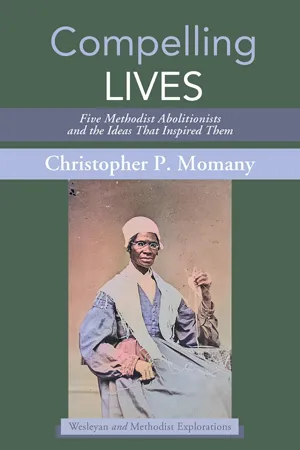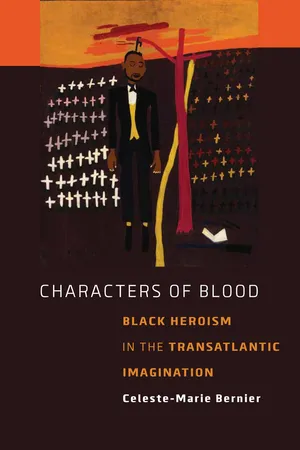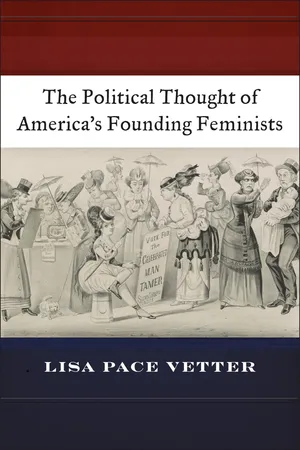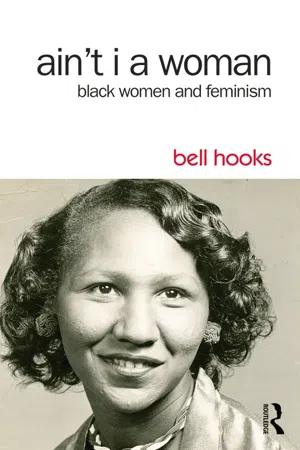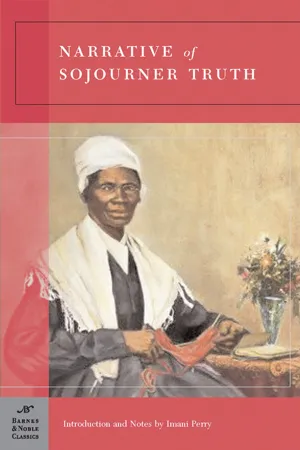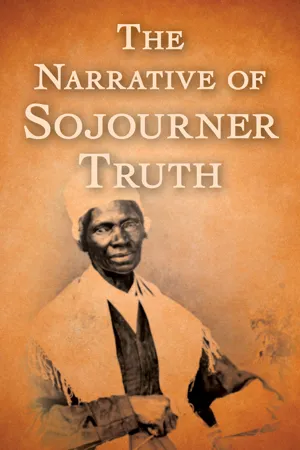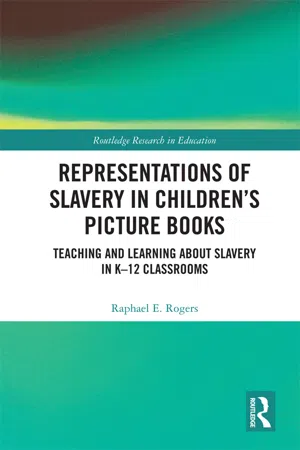History
Sojourner Truth
Sojourner Truth was an African-American abolitionist and women's rights activist. Born into slavery, she escaped to freedom and became a powerful advocate for the rights of both African Americans and women. She is best known for her powerful speech "Ain't I a Woman?" delivered at the Women's Rights Convention in 1851, which highlighted the intersectionality of race and gender in the fight for equality.
Written by Perlego with AI-assistance
Related key terms
Related key terms
1 of 4
Related key terms
1 of 3
11 Key excerpts on "Sojourner Truth"
- eBook - ePub
Compelling Lives
Five Methodist Abolitionists and the Ideas That Inspired Them
- Christopher P. Momany(Author)
- 2023(Publication Date)
- Cascade Books(Publisher)
1851 “Ain’t I a Woman?” speech has been contested by commentators for years. Newspaper accounts of that address, along with several attempts at transcribing what was heard, have left generations unsatisfied. Whose recollection captured the essence of Sojourner Truth? How did cultural assumptions of the time distort the speech? If one peeled back the layers of memory, could one get to her exact words?Such questions have a way of backfiring on us. Those who deconstruct various printed versions of this speech typically claim to be unleashing the real Sojourner Truth. But even these efforts manipulate more than they liberate. Attempts to reach the pure message presume that she requires someone else to free her. We should always remember that, even though state law released Truth in 1828 , she walked away from slavery on her own terms before then, and the only one who ever really freed her was the God who loved her.121On April 26 , 1850, the abolitionist newspaper The Liberator carried the following announcement: “JUST PUBLISHED, And for Sale at the Anti-Slavery Office, 21 Cornhill, NARRATIVE OF Sojourner Truth, a Northern Slave, Emancipated from Bodily Servitude by the State of New York in 1828 . With a Portrait.”122 This very paper also contained blistering commentary aimed at the pending legislation in Washington that would nationalize the recapture of people leaving slavery. April 1850 was a critical month for Sojourner Truth. It marked the agency and self-determination that comes with being a homeowner, the premiere of her autobiography, and the ominous foreshadowing of so-called Fugitive Slave legislation. As her personal life became better established, the nation stumbled toward even more systematic oppression.Frederick Douglass feared that any law mandating the nationwide pursuit of those escaping bondage would drive thousands on to Canada. He labeled the legislation the “Bloodhound Bill.” When enacted in September of 1850 , the new law served as an accelerant for the fire consuming America.123 Many abolitionists referred to the act with disdain; they continued to call it the “Fugitive Slave Bill,” even after it was signed. Nothing so contrary to the divine will could ever be termed a legitimate law.124 - eBook - ePub
Preaching God's Transforming Justice
A Lectionary Commentary, Year B
- Ronald J. Allen, Dale P. Andrews, Dawn Ottoni-Wilhelm(Authors)
- 2011(Publication Date)
- Westminster John Knox Press(Publisher)
Sojourner Truth Day (August 18)JoAnne Marie Terrell
JEREMIAH 3:19–25PSALM 106:1–5, 40–482 CORINTHIANS 3:12–4:2LUKE 1:26–38Born into slavery about 1797 in Ulster County, New York, Isabella Baumfree experienced a religious conversion and call to public ministry in 1843.1 New York, like other northern states, had “gradual” emancipation laws, but Isabella knew in her heart that God had already set her free. So she “told Jesus it would be all right if he changed [her] name” because when she left the state of bondage she wanted “nothin’ of Egypt” left on her account. According to her story, the name Sojourner was given to her in a vision, for she understood that she was to walk about the country preaching and doing God’s will. To this name she added Truth, becoming a great advocate in the cause of freedom from oppression for African Americans and women.An extraordinary orator, Sojourner followed her call to lecture and preach for the rights of women and the abolition of slavery. Her work included advocating for black soldiers during the Civil War, opposing the death penalty, and calling for other civic liberties. Her speech “Ain’t I a Woman?” addressed to the Ohio Women’s Rights Convention in 1851, is among the most persuasive, moving, and timeless testimonies to the God-given rights of women. On this Holy Day for Justice, when we celebrate women’s suffrage in the United States, we remember Sojourner Truth’s powerful and enduring civil rights ministry on behalf of women, African Americans, and all God’s people.Then that little man … says, “Women can’t have as much rights as men, because Christ was not a woman.” Where did your Christ come from? … From God and a woman. Man had nothing to do with him.2 - eBook - ePub
Characters of Blood
Black Heroism in the Transatlantic Imagination
- Celeste-Marie Bernier(Author)
- 2012(Publication Date)
- University of Virginia Press(Publisher)
1 Intent not only upon securing this historical figure's approval but upon bearing witness to genealogies of black female resistance, Obama vouchsafes Truth's status as a reusable symbol and touchstone for black female spiritual, political, social, and cultural emancipation. Signifying as a point of origin for the overthrow of nefarious paradigms of gender no less than race subjugation, for Obama, Lane, and many others, Truth functions as an archetypal embodiment of the ongoing fight for black female equality. Similarly, she operates as an emblem of the political necessity for an idealized belief in the inevitability of American progress more generally. In forceful ways, Lane's twenty-first-century memorialization of Truth remains inspired by and indebted to the life and works of this historical figure. Perpetually at war against static, one-dimensional and mythologized representations of black womanhood unless they originated in her own speeches and narratives, Sojourner Truth's life and works testify to her fight to elude fixity and defy definition as she engaged in diverse signifying practices.African. Legend. Prophet. Orator. Fugitive. Feminist. Performer. Trickster. Mother. Wife. Symbol. Daughter. Heroine. This chapter examines the diverse cultural and historical imagining of Isabella Van Wagenen, or Isabella Baumfree, iconically reborn as Sojourner Truth in a symbolic act of self-naming following her escape from slavery. Even in the early nineteenth century, attempts by white abolitionists such as Gilbert Vale to dismiss Truth as “a poor, coloured, unlettered woman” failed in light of her self-conscious performances. “From our listening to this coloured female,…we have discovered that she…is not exactly what she seems,” he was forced to concede. In telling ways, her deliberate obfuscations of language secured his frustration: “She is not communicative, and if circumstances did not prompt her to tell all she knows, it would be difficult to get at it.”2 - Lisa Pace Vetter(Author)
- 2017(Publication Date)
- NYU Press(Publisher)
7The Shadow and the Substance of Sojourner Truth
It seems fitting to conclude this book with a brief examination of one of the most elusive and complex figures in the early women’s rights and abolitionist movements. This title, “The Shadow and the Substance of Sojourner Truth,” is taken from a message printed on a carte de visite, a small collectible photograph, bearing Truth’s image. Truth publicly emerged among abolitionist and early women’s rights circles on the heels of Elizabeth Cady Stanton with the publication of her autobiography, The Narrative of Sojourner Truth, in 1850, and with her appearance a year later at the Women’s Rights Convention in Akron, Ohio, where she delivered her famous “Ain’t I a Woman” speech.The analysis of several early women’s rights advocates and abolitionists that I have presented in this book provides a rich framework with which to examine Truth’s important yet neglected contribution to American political thought. The emergence of ridicule in Stanton’s work as a powerful rhetorical tool for reform helps us better understand Truth’s frequent deployment of the tactic in her own speeches and writings. The central role of Quaker faith in shaping the theoretical contributions of Angelina and Sarah Grimké and Lucretia Mott prepares us to appreciate the influence of Truth’s religious convictions on her arguments to end slavery and the oppression of women. Indeed, Truth was aided early on by Quakers, who helped her wage a successful lawsuit to free her illegally enslaved son and continued their support throughout her career, even inspiring her mode of dress.1 In the Book of Life, a collection of newspaper articles, letters, autographs, statements, and other works written for and about Truth, Lucretia Mott signed herself as Truth’s “co-laborer in the cause of our race.”2- eBook - ePub
Sojourner Truth and Intersectionality
Traveling Truths in Feminist Scholarship
- Katrine Smiet(Author)
- 2020(Publication Date)
- Routledge(Publisher)
Post/secular Truths Sojourner Truth at the intersection of gender, race, and religionIn 1843, Isabella Baumfree chose the name “Sojourner Truth” as an alternative to the name she was given as an enslaved woman. In the Narrative of Sojourner Truth, this act of self-naming is connected to Truth’s divine calling to travel around the country to speak and preach (Perry 2005 [1859], 73). The name expresses her commitment to spread the “truth” of God as a traveling (“ sojourning”) preacher, and is thus both divinely inspired and religiously meaningful. In the “Ain’t I a Woman?” speech, religion is brought up in at least four instances. First of all, Truth refers to her suffering as an enslaved mother stating that she was abandoned by everyone except for Jesus, who heard her call out in grief. In other words, while those around her had no eye for her suffering, she found solace in her faith. When a clergyman in the audience argues that women should not have any rights because “Christ was not a woman,” Truth effectively and humorously dismisses the argument of Christ’s maleness to justify women’s inferiority. She responds: “where did your God come from? From God and a woman, man had nothing to do with him”. Thirdly, Truth refers to Eve and the original sin, suggesting that it should be read positively as a sign of women’s strength that should be put to use to fight against injustices. She argues: “If the first woman God ever made was strong enough to turn the world upside down all alone, these women together ought to be able to turn it back, and get it right side up again!”. Lastly, Truth asserts that “I have ploughed and planted, and gathered into barns, and no man could head me!”. This assertion that “no man could head me” could be interpreted as defiance of the religious notion of male headship: the idea that men are natural and logical leaders of both church and family.1 - eBook - ePub
This Far By Faith
Readings in African-American Women's Religious Biography
- Judith Weisenfeld, Richard Newman(Authors)
- 2014(Publication Date)
- Routledge(Publisher)
67 Sojourner Truth sold the shadow to support the substance when the substance was her own bodily subsistence and when the substance was her place in history. She appropriated the power of the American gaze and used it in her own mimesis.Truth’s widely circulated photographs traveled in broad currents of American culture, for by popularizing the photographic image, cartes de visite such as hers contributed to the simplification of experience, easing individuality into directly grasped symbol.68 In the nineteenth century this process made Sojourner Truth = “the Libyan Sibyl” = black exotic, and in the twentieth century, it made Sojourner Truth = “Ar’n’t I a woman?” = strong (black) woman. In exchange for handy symbolism, however, something less predictable is lost: the complicated and unexpected experience of a northern ex-slave and itinerant preacher who invented Sojourner Truth in New York City in 1843 and who made herself into a familiar figure among feminist abolitionists through the sale of endlessly reproducible objects. Her little photographs could speak to people of all nations (feminists and nonfeminists), but like the voice of the Holy Spirit, their meaning remains powerful and ambiguous.APPENDIX 1This is the report of Sojourner Truth’s speech in Akron, Ohio, in 1851 as it appears in the Salem [Ohio] Anti-Slavery Bugle, June 21, 1851, reported by Marius Robinson. The newspaper is held by the American Antiquarian Society, Worcester, Massachusetts.One of the most unique and interesting speeches of the Convention was made by Sojourner Truth, an emancipated slave. It is impossible to transfer it to paper, or convey any adequate idea of the effect it produced upon the audience. Those only can appreciate it who saw her powerful form, her whole-souled, earnest gestures, and listened to her strong and truthful tones. She came forward to the platform and addressing the President said with great simplicity: - eBook - ePub
Ain't I a Woman
Black Women and Feminism
- bell hooks(Author)
- 2014(Publication Date)
- Routledge(Publisher)
5 Black Women and Feminism DOI: 10.4324/9781315743264-6More than a hundred years have passed since the day Sojourner Truth stood before an assembled body of white women and men at an anti-slavery rally in Indiana and bared her breasts to prove that she was indeed a woman. To Sojourner, who had traveled the long road from slavery to freedom, the baring of her breasts was a small matter. She faced her audience without fear, without shame, proud of having been born black and female. Yet the white man who yelled at Sojourner, “I don’t believe you really are a woman,” unwittingly voiced America’s contempt and disrespect for black womanhood. In the eyes of the 19th century white public, the black female was a creature unworthy of the title woman; she was mere chattel, a thing, an animal. When Sojourner Truth stood before the second annual convention of the women’s rights movement in Akron, Ohio, in 1852, white women who deemed it unfitting that a black woman should speak on a public platform in their presence screamed: “Don’t let her speak! Don’t let her speak! Don’t let her speak!” Sojourner endured their protests and became one of the first feminists to call their attention to the lot of the black slave woman who, compelled by circumstance to labor alongside black men, was a living embodiment of the truth that women could be the work-equals of men.It was no mere coincidence that Sojourner Truth was allowed on stage after a white male spoke against the idea of equal rights for women, basing his argument on the notion that woman was too weak to perform her share of manual labor— that she was innately the physical inferior to man. Sojourner quickly responded to his argument, telling her audience:…Well, children, whar dar is so much racket dar must be something out o’ kilter. I tink dat ‘twixt de niggers of de Souf and de women at de Norf all a talkin ‘bout rights, de white men will be in a fix pretty soon. But what’s all dis here talkin’ ‘bout? Dat man ober dar say dat women needs to be helped into carriages, and lifted ober ditches, and to have de best places… and ain’t I a woman? Look at me! Look at my arm!… I have plowed, and planted, and gathered into barns, and no man could head me—and ain’t I a woman? I could work as much as any man (when I could get it), and bear de lash as well—and ain’t I a woman? I have borne five children and I seen ’em mos all sold off into slavery, and when I cried out with a mother’s grief, none but Jesus hear—and ain’t I a woman? - Sojourner Truth(Author)
- 2009(Publication Date)
- Barnes & Noble Classics(Publisher)
“Near Mt. Pleasant, Iowa, 1863.”In April, 1863, a lengthy account of Sojourner’s life was published in the Atlantic Monthly, entitled, “Sojourner Truth, the Libyan Sibyl,” written by Mrs. H. B. Stowe. This graphic sketch not only gave Sojourner greater notoriety, but added fresh laurels to Mrs. Stowe’s increasing fame as an authoress. The description of her person and the portrayal of her character are so vivid that it finds a fitting place in her Book of Life, and is here fully given.Sojourner Truth, the Libyan Sibyl.
Many years ago, the few readers of radical abolitionist papers must often have seen the singular name of Sojourner Truth, announced as a frequent speaker at anti-slavery meetings, and as traveling on a sort of self-appointed agency through the country. I had myself often remarked the name, but never met the individual. On one occasion, when our house was filled with company, several eminent clergymen being our guests, notice was brought up to me that Sojourner Truth was below, and requested an interview. Knowing nothing of her but her singular name, I went down, prepared to make the interview short, as the pressure of many other engagements demanded.When I went into the room, a tall, spare form arose to meet me. She was evidently a full-blooded African, and though now aged and worn with many hardships, still gave the impression of a physical development which in early youth must have been as fine a specimen of the torrid zone as Cumberworth’s celebrated statuette of the Negro Woman at the Fountain. Indeed, she so strongly reminded me of that figure, that, when I recall the events of her life, as she narrated them to me, I imagine her as a living, breathing impersonation of that work of art.I do not recollect ever to have been conversant with any one who had more of that silent and subtle power which we call personal presence than this woman. In the modern spiritualistic phraseology, she would be described as having a strong sphere. Her tall form, as she rose up before me, is still vivid to my mind. She was dressed in some stout, grayish stuff, neat and clean, though dusty from travel. On her head she wore a bright Madras handkerchief, arranged as a turban, after the manner of her race. She seemed perfectly self-possessed and at her ease; in fact, there was almost an unconscious superiority, not unmixed with a solemn twinkle of humor, in the odd, composed manner in which she looked down on me. Her whole air had at times a gloomy sort of drollery which impressed one strangely.- eBook - ePub
- Sojourner Truth, Olive Gilbert(Authors)
- 2017(Publication Date)
- Open Road Media(Publisher)
The Narrative of Sojourner Truth Sojourner TruthPassage contains an image HER BIRTH AND PARENTAGE
The subject of this biography, Sojourner TruthColonel Ardinburgh belonged to that class of people called Low Dutch., as she now calls herself—but whose name, originally, was Isabella—was born, as near as she can now calculate, between the years 1797 and 1800. She was the daughter of James and Betsey, slaves of one Colonel Ardinburgh, Hurley, Ulster County, New York.Of her first master, she can give no account, as she must have been a mere infant when he died; and she, with her parents and some ten or twelve other fellow human chattels, became the legal property of his son, Charles Ardinburgh. She distinctly remembers hearing her father and mother say, that their lot was a fortunate one, as Master Charles was the best of the family,—being, comparatively speaking, a kind master to his slaves.James and Betsey having, by their faithfulness, docility, and respectful behavior, won his particular regard, received from him particular favors—among which was a lot of land, lying back on the slope of a mountain, where, by improving the pleasant evenings and Sundays, they managed to raise a little tobacco, corn, or flax; which they exchanged for extras, in the articles of food or clothing for themselves and children. She has no remembrance that Saturday afternoon was ever added to their own time, as it is by some masters in the Southern States.Passage contains an image ACCOMMODATIONS
Among Isabella’s earliest recollections was the removal of her master, Charles Ardinburgh, into his new house, which he had built for a hotel, soon after the decease of his father. A cellar, under this hotel, was assigned to his slaves, as their sleeping apartment,—all the slaves he possessed—of both sexes, sleeping (as is quite common in a state of slavery) in the same room. She carries in her mind, to this day, a vivid picture of this dismal chamber; its only lights consisting of a few panes of glass, through which she thinks the sun never shone, but with thrice reflected rays; and the space between the loose boards of the floor, and the uneven earth below, was often filled with mud and water, the uncomfortable splashings of which were as annoying as its noxious vapors must have been chilling and fatal to health. She shudders, even now, as she goes back in memory, and revisits this cellar, and sees its inmates, of both sexes and all ages, sleeping on those damp boards, like the horse, with a little straw and a blanket; and she wonders not at the rheumatisms, and fever-sores, and palsies, that distorted the limbs and racked the bodies of those fellow-slaves in after-life. Still, she does not attribute this cruelty—for cruelty it certainly is, to be so unmindful of the health and comfort of any being, leaving entirely out of sight his more important part, his everlasting interests,—so much to any innate or constitutional cruelty of the master, as to that gigantic inconsistency, that inherited habit among slaveholders, of expecting a willing and intelligent obedience from the slave, because he is a - eBook - ePub
Representations of Slavery in Children's Picture Books
Teaching and Learning about Slavery in K-12 Classrooms
- Raphael Rogers(Author)
- 2018(Publication Date)
- Routledge(Publisher)
Black Women in America: An Historical Encyclopedia (1993), The Narrative of Sojourner Truth (1998), and Notable American Women 1607–1950(1971).Exercise of Power Among Characters
Sojourner Truth’s Step-Stomp Stride is told from the third-person point of view. Throughout the text, the narrator shares what the characters, Sojourner, slave master John Dumont, a Quaker couple, and an abolitionist named Olive, see, think, feel, do, and observe. From the beginning to the end of the story, the reader is provided with an opportunity to gain much insight into the thoughts and feelings of the main character, Sojourner Truth. While Pinkney provides the reader with some details about the lives of the other characters, it is Sojourner’s thoughts, feelings, and observations that are featured prominently throughout the story. Pinkney’s colloquial narrative and punchy poetic prose help to create an upbeat narrative about Sojourner’s lifeSojourner
As the story begins, Sojourner appears to be in a powerful position with some agency in the world. The first page of the book features an illustration of Sojourner. She has a book in hand, there is a bag across her waist, and she has a stoic look upon her face. The framed image signals to readers that they are about to enter Sojourner’s world of slavery, and her visage and the yellowish color of the reader hint at the inner strength and warmth of the character. The image hints at Sojourner’s commitment to helping bring an end to slavery through travels that will take her to places where she will tell the truth about slavery. Beneath this picture, Davis Pinkney writes, “She was big. She was black. She was so beautiful [and] her name was Sojourner” (p. 1). Furthermore, she continues, “She was meant for great things. Meant for speaking. Meant for preaching. Meant for teaching the truth about freedom. Big. Black. Beautiful. True. That was Sojourner” (p. 1). - eBook - ePub
- (Author)
- 2009(Publication Date)
- Perlego(Publisher)
Gage said: I have but little to say because it is almost two o'clock, and hungry and weary people are not good listeners to speeches. I shall confine my remarks therefore to one special point brought up this morning and not fully discussed. Sojourner Truth gave us the whole truth in about fifteen words: "If I am responsible for the deeds done in my body, the same as the white male citizen is, I have a right to all the rights he has to help him through the world." I shall speak for the slave woman at the South. I have always lifted my voice for her when I have spoken at all. I will not give up the slave woman into the hands of man, to do with her as he pleases hereafter. I know the plea that was made to me in South Carolina, and down in the Mississippi valley. They said, "You give us a nominal freedom, but you leave us under the heel of our husbands, who are tyrants almost equal to our masters." The former slave man of the South has learned his lesson of oppression and wrong of his old master; and they think the wife has no right to her earnings. I was often asked, "Why don't the Government pay my wife's earnings to me?" When acting for the Freedman's Aid Society, the orders came to us to compel marriage, or to separate families. I issued the order as I was bound to do, as General Superintendent of the Fourth Division under General Saxton. The men came to me and wanted to be married, because they said if they were married in the church, they could manage the women, and take care of their money, but if they were not married in the church the women took their own wages and did just as they had a mind to. But the women came to me and said, "We don't want to be married in the church, because if we are our husbands will whip the children and whip us if they want to; they are no better than old masters." The biggest quarrel I had with the colored people down there, was with a plantation man because I would not furnish a nurse for his child
Index pages curate the most relevant extracts from our library of academic textbooks. They’ve been created using an in-house natural language model (NLM), each adding context and meaning to key research topics.
Explore more topic indexes
Explore more topic indexes
1 of 6
Explore more topic indexes
1 of 4
